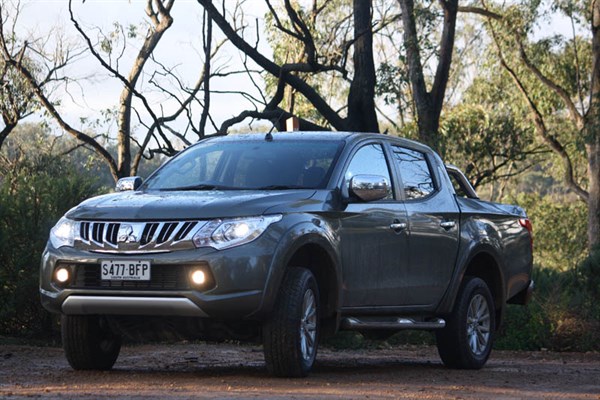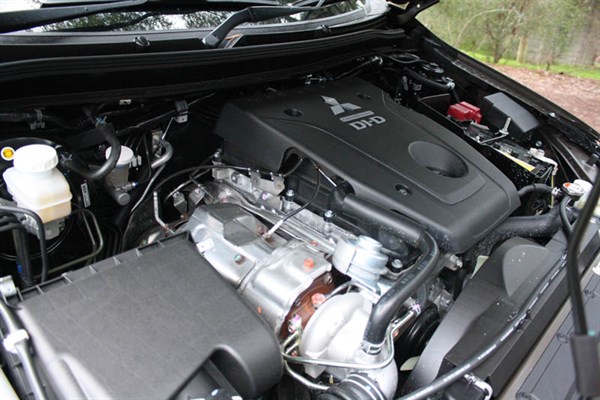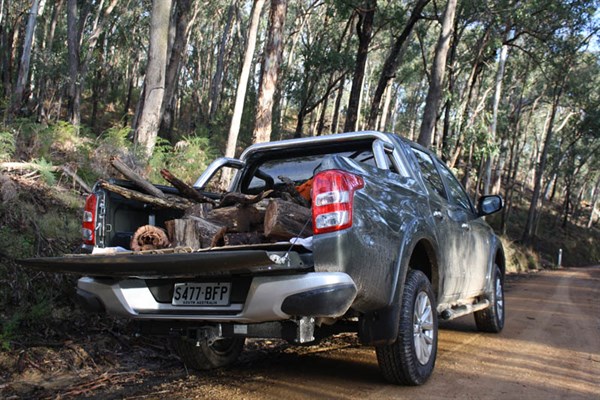The Mitsubishi Triton has had its biggest update for nearly a decade. MATT WOOD takes the wheel and gets back to nature.
There’s something about a rural winter in the south that makes anyone who has a wood fire become fuel obsessed.
So as self-serving as it may seem, the newly launched Mitsubishi Triton landed in my driveway just as I needed to go and add to my firewood reserves.
The Triton range
The range starts with the GLX which is available in 4×2 single cab and double cab. The GLX 4×4 is available as a single cab, club cab or as a dual cab.
Tilt telescopic steering wheel and a Bluetooth enabled stereo unit are standard equipment. All models get 7 airbags including a knee protecting bag for the driver. Manual models get Hill Start Assist to stop roll backs when taking off on a grade.
The GLS model plays more to the work play/market and ups the equipment and comfort level. A 6-inch touch screen multi-media unit is standard on the GLS and range topping Exceed.
Both the GLS and the Exceed get Bi-Xenon headlights, daytime LED running lights, 17-inch alloy wheels, leather bound steering wheel and gear shift as well as dual zone climate control.
But the luxo pack Exceed also features dusk sensing headlights, auto wipers, leather trim, electric driver’s seat adjustment, paddle shift for the auto tranny and push button start.
The truck is 80 per cent new and only chassis and floor of the outgoing model remain. Unfortunately the styling of the 2016 Triton hasn’t deviated too much from the soggy and unflattering design brief of the previous offering.
The Triton has in recent times tended towards making a statement about value rather than macho credibility. And the new ute now has a rather unsettling toothy grin on its face.
My grey double cab GLS also arrived sporting a sport bar on its rump and side steps. As much as I squinted at it I still can’t come at the looks even with slightly ritzy alloy wheels.
But as with some other ugly ducklings on the market I’m sure there will be no shortage of aftermarket bars available to beef up the swoopy front of the Triton for those who want a tougher looking truck.
Engine and transmission
Standard across the range is a new 2.4 litre turbo-diesel Mivec powerplant that provides 133kW of grunt and 430Nm of twisting power. Peak torque is at 2500rpm and peak power is from 3500rpm.
While it may not be cranking out the numbers its competitors are, the 2.4 litre donk is exceptionally civilized. Power delivery is quiet though the engine does suffer from turbo lag under 2000rpm.
When wandering through traffic there’s a noticeable delay in performance until the tacho needle gets above 2 grand.
My GLS was furnished with a 6-speed manual ‘box which proved to be a slick shifter and most un-truck like.
Loading
Single cab variants boast payloads from 1165kg to 1240kg while double cab models sport payloads of between 950kg to 980kg depending on spec.
The range topping Exceed comes in with the lowest payload of 935kg.
Considering the GLS starts at $40,990 (plus on roads) it certainly brings plenty of standard kit to the table and really backs up the value proposition that the Triton has always traded on.
Tub access is typical of most of today’s high sided utes but I was still able to sling my chainsaw over the side and tie it down without too many contortions on my part.
The load area itself is impressive for a double cab and measures 1520mm long by 1470mm. Tie down point are handily spaced, though a tie down rail would be much handier for regular load luggers.
Cab and controls
Climbing into the driver’s seat reveals a very nicely laid out interior. All controls are easily reached and the simply instrument cluster is easy to read. And the fabric seats turned out to be very comfortable.
Large folding electric mirrors give excellent vision down both sides of the ute tub and given the high hipped design of the new Mitzy over the shoulder visibility is quite good too.
Rear seating has improved from the previous model but the long and lanky will want to stick to the front seats.
Some of the improvement in space has come from dropping the opening rear windscreen that was a signature part of the previous design.
Performance
On-road
Mitsubishi is keen to point out the Triton’s class leading turning circle of 11.8 metres. This is mainly down to the rather short 3 metre wheel base of the ute.
The Triton sat on the highway beautifully, as I wound my way through the countryside. Noise levels while cruising are excellent.
The ride however is a tad twitchy; again the short wheel base of the Triton comes into play. While it handles well the ride can be a little choppy even taking into account that it is an empty pick up.
Once off road the Super Select II 4WD system was only a twist of the dial away. This shift-on-the-fly set up is excellent and lets you adopt full-time 4wd on the move at speeds of up to 100 km/h effectively making the Triton all-wheel-drive on slippery road surfaces.
This also still provides the Triton with 4WD high and low range 4WD for off-road duties.
Base GLX models however have to make do with the Easy Select 4WD system that is still operated by a dial but only offers 2 wheel drive and 4WD High and Low. Personally I’d like to see the Super Select II system standard across the range.
I spun the dial into full-time 4WD once on the greasy forest tracks and just let the Triton idle along following its nose. As the road deteriorated I was tempted to select 4WD high but found that the Mitzy was sure footed enough as is so let the dial be.
Off-Road
The Triton will deal with most every day off-road situations quite easily. In fact the only thing that really tempered my enthusiasm in the muck was the fairly tame crossover rubber that the Mitzy was wearing.
Angle of approach for the little truck is a respectable 30 degree but the rear overhang of the ute body means that angle of departure is reduced to 22 degrees.
The peace and tranquillity of the Australian bush can only really be truly enjoyed when viewed through safety goggles and while wearing ear muffs. And bird song can only really be appreciated over the scream of a two stroke engine. Let face it there’s stuff that can kill you out there!
I stacked the Triton with a modest load and headed for home. With a load on board the Mitzy understeers pretty heavily. Again much of this is due to so much of the load area being located behind the rear axle.
Single cab and club cab models won’t have anywhere near the issues being equipped with a larger load area with room forward of the rear axle. Handling aside, the Mivec donk still performed well under load as long as you keep it up in the rev range.
Verdict
The new Triton is a big step in the right direction for Mitsubishi.
The ute has become a much more civilized and easy-to-live-with dual purpose vehicle, and the value equation is even better now with a well-priced line up.
Specifications
Mitsubishi Triton GLS Double Cab 4×4
Engine: Mivec Common Rail 2.4 litre turbo-diesel
Power: 133kW @ 3500rpm
Torque: 430Nm @ 2500rpm
Transmission: 6-speed manual (5-speed automatic optional)
Payload: 950kg
Towing: 3100kg (braked)
ANCAP Rating: 5 stars
Price: $40,990- $43,490 MRLP
For the detailed report, pick up a copy of New Farm Machinery magazine issue 26 on sale 14 September.
Subscribe to the magazine using the button below to never miss an issue.
Find Mitsubishi utes and vans for sale
Photography: Matt Wood











